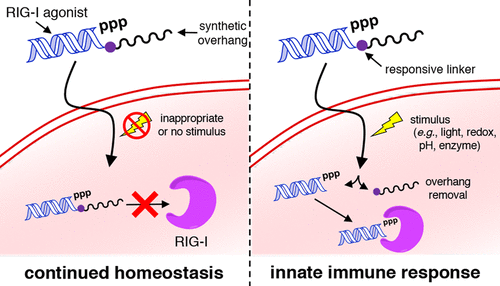当前位置:
X-MOL 学术
›
Bioconjugate Chem.
›
论文详情
Our official English website, www.x-mol.net, welcomes your feedback! (Note: you will need to create a separate account there.)
Environmentally Triggerable Retinoic Acid-Inducible Gene I Agonists Using Synthetic Polymer Overhangs
Bioconjugate Chemistry ( IF 4.7 ) Pub Date : 2018-01-19 00:00:00 , DOI: 10.1021/acs.bioconjchem.7b00697 Christian R. Palmer , Max E. Jacobson , Olga Fedorova , Anna M. Pyle , John T. Wilson
Bioconjugate Chemistry ( IF 4.7 ) Pub Date : 2018-01-19 00:00:00 , DOI: 10.1021/acs.bioconjchem.7b00697 Christian R. Palmer , Max E. Jacobson , Olga Fedorova , Anna M. Pyle , John T. Wilson

|
Retinoic acid-inducible gene I (RIG-I) is a cytosolic pattern recognition receptor (PRR) that potently activates antiviral innate immunity upon recognition of 5′ triphosphorylated double-stranded RNA (pppRNA). Accordingly, RNA ligands of the RIG-I pathway have recently emerged as promising antiviral agents, vaccine adjuvants, and cancer immunotherapeutics. However, RIG-I is expressed constitutively in virtually all cell types, and therefore administration of RIG-I agonists causes risk for systemic inflammation and possible dose-limiting toxicities. Here, we establish proof-of-concept and initial design criteria for pppRNA prodrugs capable of activating the RIG-I pathway in response to specific environmental stimuli. We show that covalent conjugation of poly(ethylene glycol) (PEG) to the 3′ end of the complementary strand, i.e., on the same side but opposite strand as the 5′ triphosphate group, can generate a synthetic overhang that prevents RIG-I activation. Additionally, conjugation of PEG through a cleavable linker—here, a reducible disulfide bond—allows for removal of the synthetic overhang and restoration of immunostimulatory activity. Furthermore, we demonstrate that blockade of RIG-I activation via synthetic overhangs is dependent on PEG molecular weight, with a critical molecular weight between 550 and 1000 Da required to inhibit activity. Additionally, we demonstrate that blockade of RIG-I activity is conjugation site-dependent, as ligation of PEG to the opposite end of the RNA did not influence ligand activity. Collectively, this work demonstrates that conjugation of synthetic polymer overhangs to pppRNA through cleavable linkers is a viable strategy for the development of environmentally triggerable RIG-I-targeting prodrugs.
中文翻译:

环境可触发的维甲酸诱导的基因I激动剂,使用合成聚合物突出端
维甲酸诱导基因I(RIG-I)是一种胞浆模式识别受体(PRR),在识别5'三磷酸化双链RNA(pppRNA)后可有效激活抗病毒先天免疫力。因此,RIG-I途径的RNA配体最近作为有希望的抗病毒剂,疫苗佐剂和癌症免疫疗法而出现。但是,RIG-I实际上在所有细胞类型中均组成性表达,因此施用RIG-I激动剂会引起全身性炎症和可能的剂量限制性毒性。在这里,我们为能够响应特定环境刺激而激活RIG-I途径的pppRNA前药建立了概念验证和初步设计标准。我们显示,聚(乙二醇)(PEG)共价结合至互补链的3'端,即 与5'三磷酸酯基团在同一侧但相反的链上,可产生阻止RIG-I激活的合成突出端。此外,通过可裂解的接头(此处为可还原的二硫键)结合PEG,可去除合成突出端并恢复免疫刺激活性。此外,我们证明了通过合成突出端对RIG-I的激活依赖于PEG分子量,抑制活性需要在550和1000 Da之间的临界分子量。此外,我们证明RIG-I活性的阻断是结合位点依赖性的,因为PEG与RNA的另一端的连接不会影响配体的活性。总的来说,
更新日期:2018-01-19
中文翻译:

环境可触发的维甲酸诱导的基因I激动剂,使用合成聚合物突出端
维甲酸诱导基因I(RIG-I)是一种胞浆模式识别受体(PRR),在识别5'三磷酸化双链RNA(pppRNA)后可有效激活抗病毒先天免疫力。因此,RIG-I途径的RNA配体最近作为有希望的抗病毒剂,疫苗佐剂和癌症免疫疗法而出现。但是,RIG-I实际上在所有细胞类型中均组成性表达,因此施用RIG-I激动剂会引起全身性炎症和可能的剂量限制性毒性。在这里,我们为能够响应特定环境刺激而激活RIG-I途径的pppRNA前药建立了概念验证和初步设计标准。我们显示,聚(乙二醇)(PEG)共价结合至互补链的3'端,即 与5'三磷酸酯基团在同一侧但相反的链上,可产生阻止RIG-I激活的合成突出端。此外,通过可裂解的接头(此处为可还原的二硫键)结合PEG,可去除合成突出端并恢复免疫刺激活性。此外,我们证明了通过合成突出端对RIG-I的激活依赖于PEG分子量,抑制活性需要在550和1000 Da之间的临界分子量。此外,我们证明RIG-I活性的阻断是结合位点依赖性的,因为PEG与RNA的另一端的连接不会影响配体的活性。总的来说,



























 京公网安备 11010802027423号
京公网安备 11010802027423号